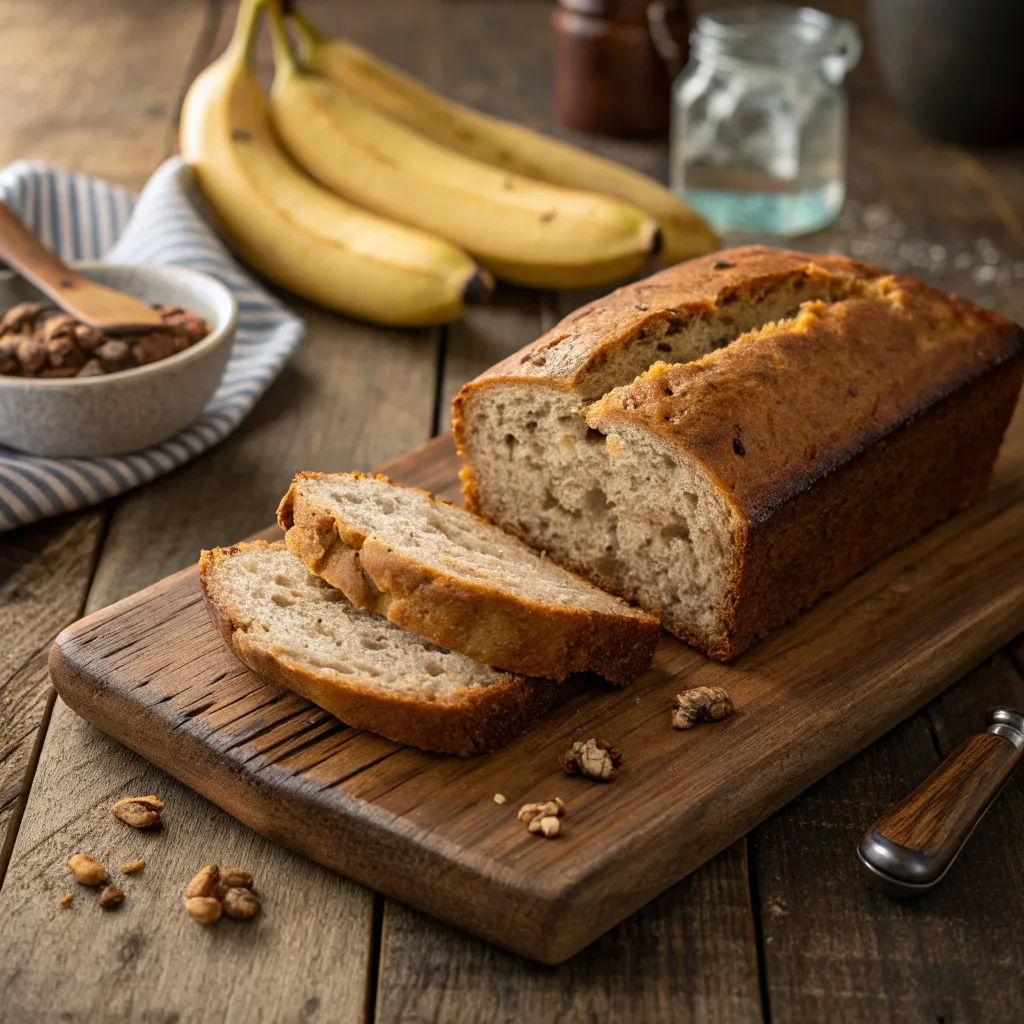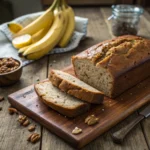Sourdough banana bread is a recipe close to my heart. Hi, I’m Helen, the cook behind Easy Tasty Kitchen. My love for food began as a little girl standing on a stool beside my mom, learning that meals bring people together. Today, I carry that same spirit into every recipe I share.
This banana bread combines two favorites — ripe bananas and sourdough starter — for a moist, flavorful loaf with the benefits of natural fermentation. It’s a healthier twist on a classic comfort food, perfect for families, busy home cooks, and anyone who loves homemade bread.
Table of Contents
Sourdough Banana Bread
A moist, tangy banana bread made with sourdough starter and ripe bananas — the perfect fermented twist on a classic comfort loaf.
- Prep Time: 15 minutes
- Cook Time: 60 minutes
- Total Time: 1 hour 15 minutes
- Yield: 1 loaf 1x
- Category: Bread
- Method: Baking
- Cuisine: American
Ingredients
- 1 cup mashed ripe bananas (about 2–3 bananas)
- 1/2 cup sourdough starter (active or discard)
- 2 eggs
- 1/3 cup oil or melted butter
- 1/2 cup sweetener (honey, maple syrup, or sugar)
- 1 1/2 cups all-purpose flour
- 1 tsp baking soda
- 1/2 tsp salt
- Optional: 1/2 cup chopped walnuts
- Optional: 1/2 cup chocolate chips
- Optional: 1 tsp cinnamon
Instructions
- Mash bananas
Mash the bananas in a mixing bowl. - Combine wet ingredients
Add sourdough starter, eggs, oil or butter, and sweetener. Mix well. - Add dry ingredients
Stir in flour, baking soda, and salt until just combined. Do not overmix. - Add optional ingredients
Fold in any optional add-ins like walnuts, chocolate chips, or cinnamon. - Pour into pan
Pour batter into a greased loaf pan. - Ferment the batter
Let the batter rest for 30 minutes to 2 hours for fermentation. - Preheat oven
Preheat oven to 350°F (175°C). - Bake
Bake for 50–60 minutes, or until a toothpick inserted in the center comes out clean. - Cool and serve
Cool completely before slicing to preserve moisture.
Notes
Ferment overnight in the fridge for a tangier flavor. Avoid overmixing to keep the crumb tender and moist.
Nutrition
- Serving Size: 1 slice
- Calories: 220
- Sugar: 10g
- Sodium: 180mg
- Fat: 9g
- Saturated Fat: 2g
- Unsaturated Fat: 6g
- Trans Fat: 0g
- Carbohydrates: 30g
- Fiber: 2g
- Protein: 4g
- Cholesterol: 35mg
What Makes Sourdough Banana Bread Special?
The Rise of Sourdough Baking at Home
Sourdough baking has become a favorite in home kitchens, thanks to its natural fermentation process. Using a sourdough starter instead of commercial yeast creates homemade bread that’s flavorful, nutritious, and easier to digest.
Why Banana Bread and Sourdough Are a Perfect Match
Banana bread is soft, sweet, and comforting. Adding sourdough starter gives it a tangy depth that balances ripe bananas perfectly, turning it into moist banana bread with an artisan touch.
Key Differences from Traditional Banana Bread
Unlike regular banana bread that uses baking soda for rise, sourdough banana bread relies on wild yeast. This creates a healthier loaf with better texture, longer freshness, and the unique benefits of probiotic baking.
Looking for More Banana Bread Ideas?
Here are a few more of our favorites you can try next:
Each of these recipes offers its own unique spin while keeping that familiar comfort we all love in banana bread.
Essential Ingredients for Sourdough Banana Bread
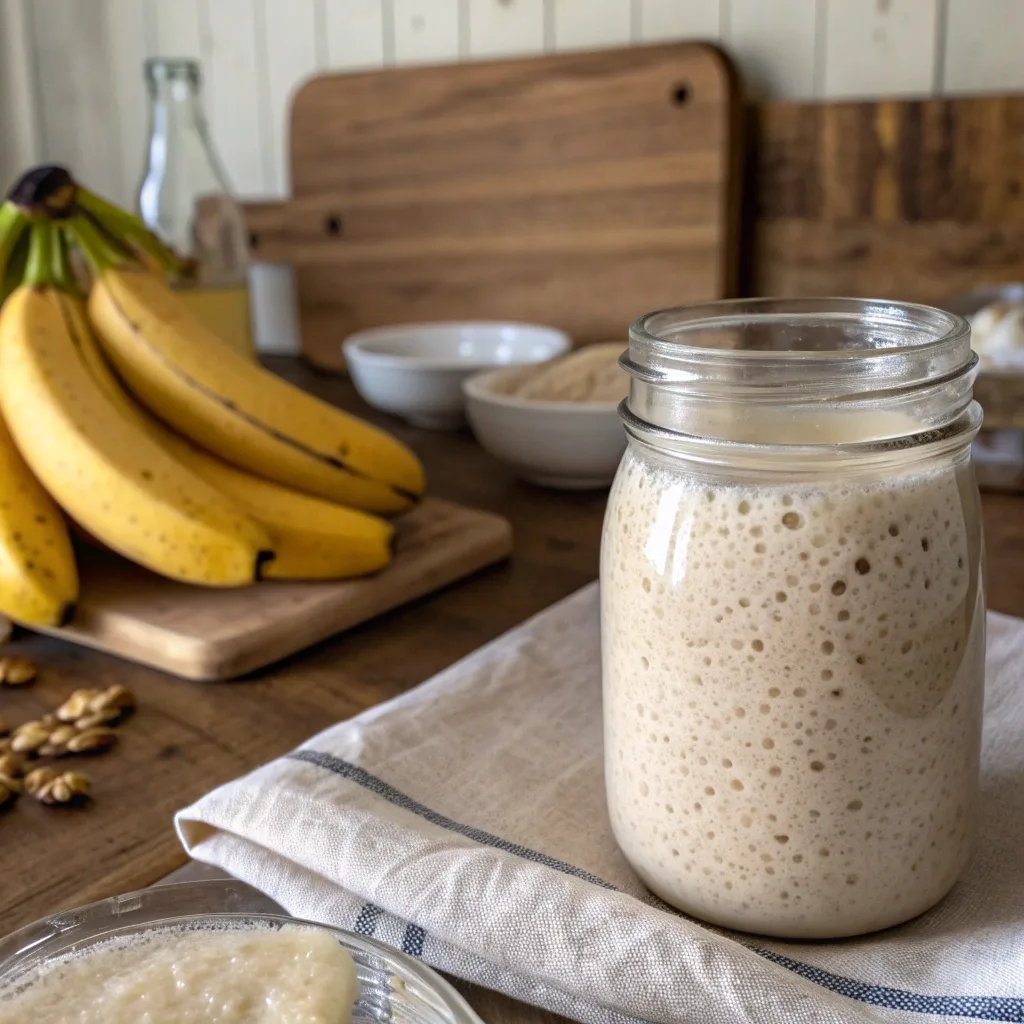
Choosing Ripe Bananas for Maximum Flavor
Use ripe bananas with brown spots for natural sweetness and a soft texture. They create moist banana bread that’s rich and flavorful.
The Role of Sourdough Starter in Baking
A sourdough starter replaces yeast, adding a gentle tang and natural fermentation. It not only helps the bread rise but also makes it healthier and easier to digest.
Optional Add-Ins: Nuts, Chocolate, and Spices
Walnuts, dark chocolate, or warm spices like cinnamon can turn your sourdough banana bread into a homemade bread full of personality.
How to Make Easy Sourdough Banana Bread at Home
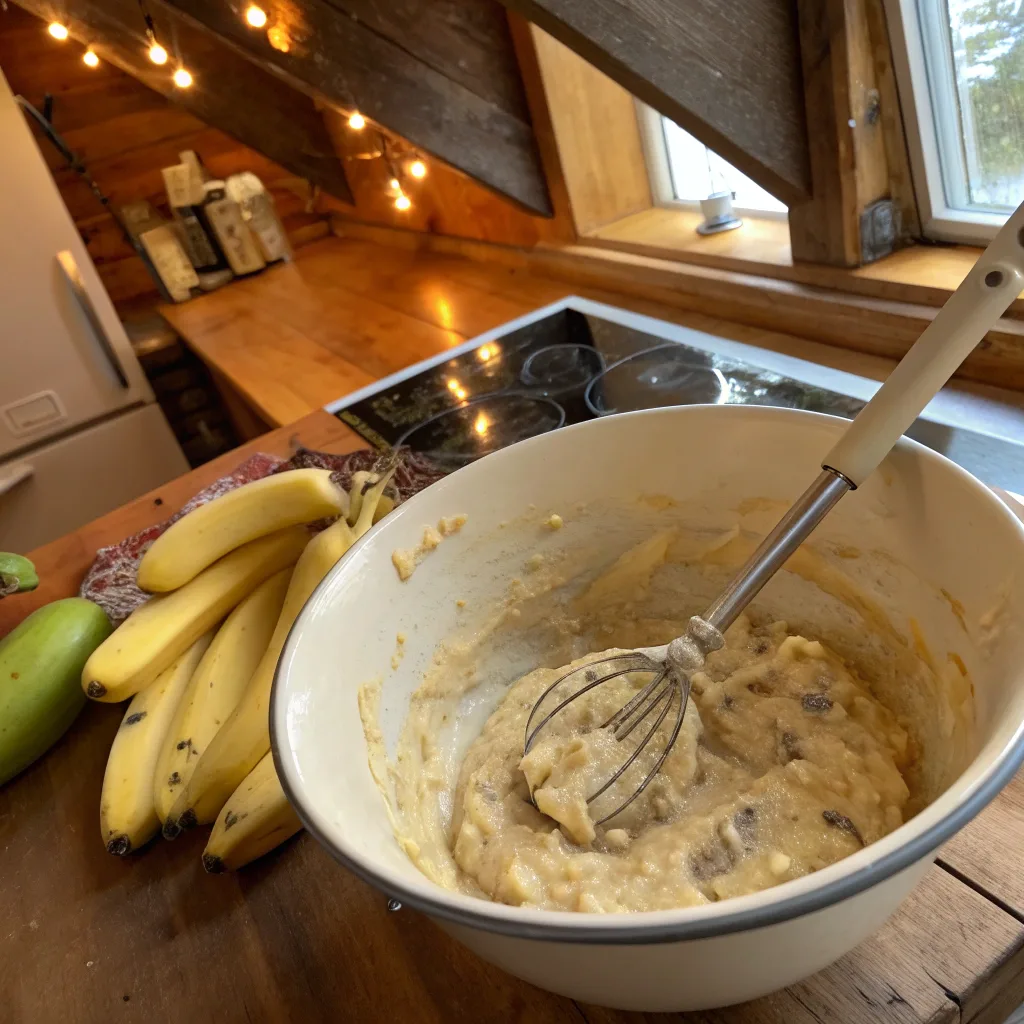
Step-by-Step Recipe Breakdown
Start by mashing ripe bananas, then mix them with sourdough starter, eggs, oil or butter, and a touch of sweetener. Fold in flour, baking soda, and salt until just combined. Pour the batter into a greased loaf pan.
Tips for Mixing and Fermenting the Batter
Don’t overmix — it can make the bread dense. Let the batter rest for a short fermentation (30 minutes to 2 hours) for added flavor and a lighter crumb.
Baking Times and Temperature Guidelines
Bake at 350°F (175°C) for 50–60 minutes until a toothpick inserted in the center comes out clean. Cool before slicing to lock in moisture.
Understanding Natural Fermentation in Banana Bread
What Happens During Fermentation
Fermentation in sourdough banana bread breaks down starches and gluten, creating a lighter texture and boosting flavor. It also adds gut-friendly benefits.
How Long to Ferment Sourdough Banana Bread
You can ferment the batter for as little as 30 minutes for quick baking or up to overnight in the fridge for deeper flavor. The longer it rests, the more tangy and complex the taste.
Signs Your Dough Is Ready for Baking
The batter should look slightly puffed and airy with small bubbles. If it feels too flat, let it rest longer before baking.
Common Mistakes in Sourdough and Banana Bread Baking
What Are Common Sourdough Mistakes?
Using an inactive starter, skipping feedings, or not allowing enough fermentation time can lead to flat or dense loaves.
The Number One Mistake in Banana Bread
Overmixing the batter is the top mistake. It develops too much gluten, leaving the bread tough instead of soft and moist.
How to Fix Dense or Dry Banana Bread
Use very ripe bananas, measure flour correctly, and avoid overbaking. Adding a touch of oil or yogurt can also keep banana bread moist.
Variations of the Recipe
Healthy Whole Grain Version
Swap in whole wheat or oat flour for part of the mix to add fiber and a nutty flavor, making the loaf more filling and nutritious.
Gluten-Free Loaf
A gluten-free flour blend works well with starter, creating a light and tender bread that’s easier to digest for sensitive eaters.
No Yeast Baking
Using discard instead of yeast gives you a naturally leavened bread with a mild tang, perfect for those who enjoy simple, wholesome bakes.
Benefits of This Fermented Banana Bread
Digestive Benefits of Natural Fermentation
The slow rise process helps break down starches and gluten, making the loaf gentler on digestion. It also supports gut health with beneficial bacteria.
Why It Can Be a Healthier Choice
Compared to standard banana loaves, this version has a deeper flavor, a lower glycemic impact, and often stays fresher for longer without preservatives.
Comparing Fermented vs. Regular Banana Bread
Regular banana bread is quick and easy, but fermentation adds a tangy complexity, better texture, and extra nutritional value.
Storage and Serving Ideas
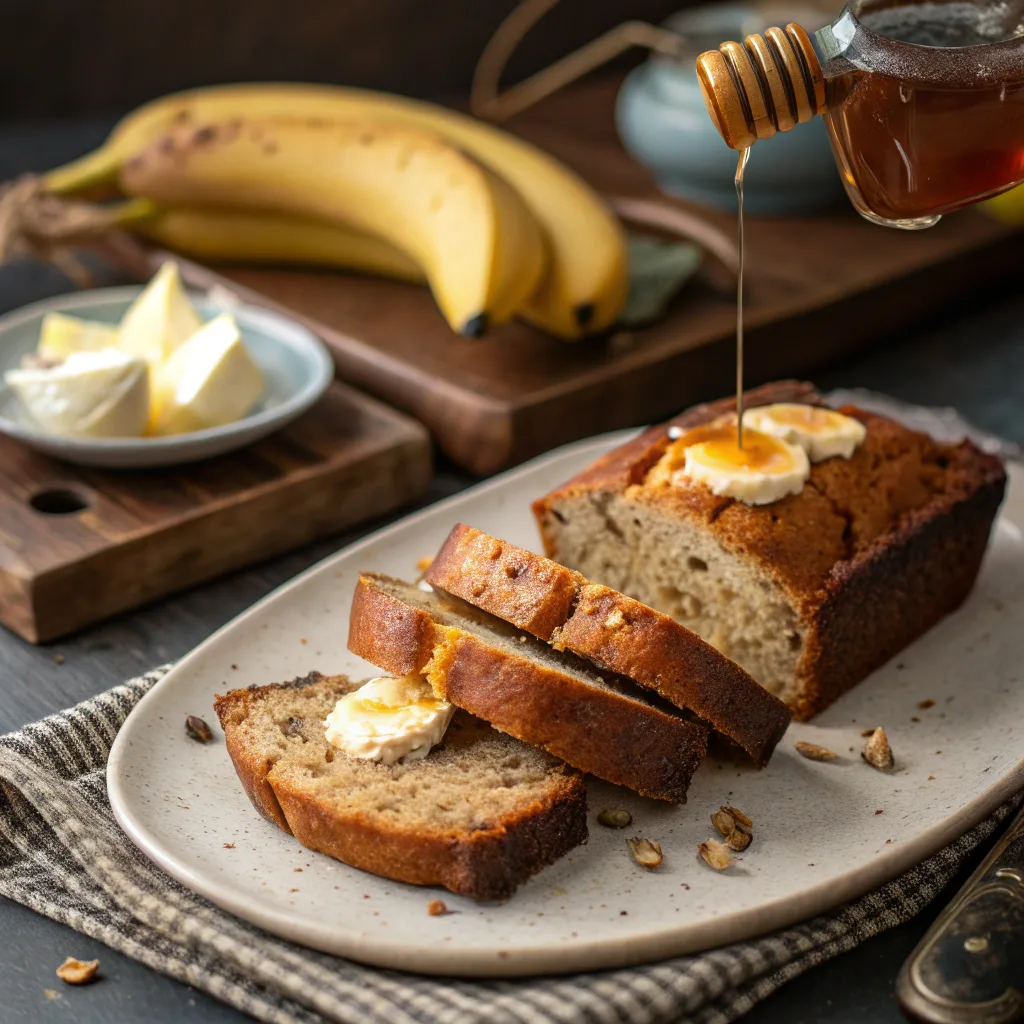
How to Store Homemade Bread for Freshness
Keep your loaf wrapped in parchment or a clean kitchen towel at room temperature for up to 3 days. Avoid plastic wrap, which traps moisture and can make it soggy.
Freezing and Reheating Banana Bread
Slice the bread before freezing so you can thaw only what you need. Warm individual slices in the toaster or oven for a fresh-baked feel.
Serving Suggestions and Toppings
Enjoy it plain, spread with butter, or topped with nut butter and honey. For a dessert-style treat, add whipped cream or a drizzle of chocolate.
Sourdough Discard Recipes and Other Baking Ideas
Creative Ways to Use Sourdough Discard
Leftover starter doesn’t need to go to waste. It can be turned into pancakes, waffles, crackers, or even muffins for a tangy twist.
Other Artisan Breads to Try
Once you’ve mastered banana bread with starter, explore rustic loaves like country-style boules, focaccia, or whole grain sandwich bread.
Expanding Your Probiotic Baking Skills
Experiment with natural fermentation in cookies, flatbreads, or even pizza dough. It’s a fun way to add flavor and gut-friendly benefits to everyday recipes.
Conclusion
Baking with a sourdough starter transforms a classic comfort recipe into something richer, healthier, and more flavorful. From choosing ripe bananas to experimenting with discard recipes, every step is a chance to create homemade bread that feels both nourishing and special.
Whether you enjoy it fresh from the oven, toasted with butter, or frozen for later, this loaf is as versatile as it is delicious. And the best part? You don’t need to be an expert baker to succeed — just a little patience and the right ingredients.
For more kitchen inspiration and behind-the-scenes cooking tips, follow us on Facebook and check out our Pinterest for even more recipe ideas you’ll love. Never miss a new recipe!
How long to ferment sourdough banana bread?
Fermentation time can range from 30 minutes to overnight. A short rest gives a mild flavor, while a longer ferment develops a stronger tang and a softer texture.
What are common sourdough mistakes?
Using a weak starter, not feeding it regularly, or skipping proper fermentation are the most common issues. These can lead to dense, flat, or sour-tasting loaves.
What is the number one mistake made when making banana bread?
Overmixing the batter. It develops too much gluten, which results in a tough, dry loaf instead of a tender, moist one.

